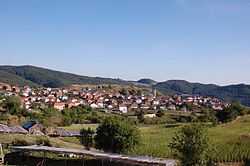Ribnovo
| Ribnovo Рибново | |
|---|---|
| Village | |
 | |
 Ribnovo | |
| Coordinates: 41°43′N 23°46′E / 41.717°N 23.767°E | |
| Country |
|
| Province | Blagoevgrad Province |
| Municipality | Garmen |
| Government | |
| • Mayor | Feim Issa (DPS) |
| Area | |
| • Total | 30.086 km2 (11.616 sq mi) |
| Population (15-12-2011 [1]) | |
| • Total | 2,446 |
| GRAO | |
| Time zone | EET (UTC+2) |
| • Summer (DST) | EEST (UTC+3) |
| Postal Code | 2967 |
| Area code(s) | 07526 |
| Website | http://www.ribnovo.com/ |
Ribnovo is an isolated mountainous village in Garmen Municipality, in Blagoevgrad Province, Bulgaria. It is situated in the Dabrash part of the Rhodope Mountains at 1152 meters altitude, 14 kilometers north-northwest from Garmen and 64 kilometers southeast of Blagoevgrad by air. The village can be reached by a 20 kilometers asphalt mountainous road from Ognyanovo through the villages Skrebatno and Osikovo.
History
Ribnovo has long history. Remains of an ancient necropolis have been unearthed near the village. In the Ottoman documents from 1478 year the village is described as "settlement with 81 non-Muslim households".[2] In 1900 year Vasil Kanchov described the village as one inhabited with 560 Bulgarian-Muslim people, living in 105 households.[3] Nowadays the village still grows and people build new houses.
Economy
There aren't any industrial subjects in this big village and the arable land is limited. Many people go to work in other settlements in the summer or abroad.
Religion
In Ribnovo people are Muslim of Pomak origin and there are two mosques.
Education and health care
In the high school "Yordan Yovkov" study more than 400 students. There is a kindergarten and a community center with a public library. There are two medical specialists, who provide health care - a general practitioner and a dentist. There is an amateur football club "Rodopa", playing in the regional league.
Culture
The wedding customs are unique to the village. It has been preserved from the old Bulgarian customs and it has been influenced by the Islamic traditions. The wedding season is during autumn and winter. The festivities last for 5 days which includes a lot of singing and dancing in the center of the village. On the second day the bride's face is painted white with sequins.
References
- ↑
- ↑ Радушев, Евгений. Помаците - християнство и ислям в Западните Родопи с долината на р.Места, XV - 30-те години на XVIII век. Част II - Приложения. София, Народна библиотека Св. Св. Кирил и Методий - Ориенталски отдел, 2005. ISBN 954-523-084-3. OCLC 166026970. с. 39-40
- ↑ Кънчов, Васил (1996) [1900]. "Неврокопска Каза". Македония. Етнография и статистика (II фототипно издание ed.). София: Проф. М. Дринов. p. 195.
- The Municipality of Garmen Guidebook, 2004
- White-painted bride honors Bulgarian Muslim rite
| ||||||||||||||||||||
